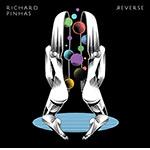
Richard Pinhas Reverse
(Bureau B)
If you ever want to feel overwhelmed by a body of work, (and I am purposely keeping Frank Zappa out of this discussion), look through the discography of Richard Pinhas, pioneering founder of the 1974 electronic rock band, Heldon. The man has worked steadily following a hiatus from the early-to late-80s, which has since resulted in a slew of solo records and collaborations with the likes of Merzbow, Wolf Eyes, Tatsuya Yoshida (Ruins, Koenjihyakkei), and Oren Ambarchi (Burial Chamber Trio, Gravetemple, Sunn O))), Eyvind Kang), who aided in the production of Pinhas’s latest outing, Reverse.
Boasting lengthy jams comprised of sounds from the avant-cosmos and instrumentation as scattered as stars at midnight, Reverse was produced during a period of loss and instability for Pinhas, its four lengthy chapters, or “DRONZ,” addressing uncertainty and dismay. With that said, the first few seconds of Dronz — Ketter are somewhat of a red herring: a calm collection of warm-up tones and taps that at first bring to mind the peaceful introduction to Miles Davis’s In A Silent Way. Drummer Arthur Narcy’s sticks begin to flail with no real pattern to speak of, and then Pinhas makes himself heard as he chokes a radiating drone out of his guitar. At points during Ketter’s sixteen-minute runtime, there’s a broken clock being right twice a day feeling, its discordance momentarily unified as if by chance.
Anchored somewhat by Narcy’s Kosmische Musik loop, the following Dronz 2 — End does provide the album its most structured track, its accents seemingly based in shoegaze with movements cutting through its heavenly air with the rapidity of call and response. This track could’ve been Can’s answer to My Bloody Valentine or Ride.
The tension rises with Dronz 3 — Nefesh, an array of tones and pulsations lining the air, working toward an onslaught of drums and percussion that carry through the track’s remaining ten or so minutes. It’s like listening to free jazz while swimming in a tank full of jellyfish: continual, undulating quivers, groans, and swells, at times losing just enough volume to hear amplified strings draw imagined lines directly through the chaos. It doesn’t thunder, or irritate. It’s almost as if Pinhas isn’t quite committed to offering this much of himself to anyone, as if, in spite of this written and performed maelstrom of odds and ends, he’s proceeding with caution.
With that said, Dronz 4 — V2, the album’s closer, is its only real tedious listen. With a veritable chorus of electronics suffocating any available space, the track’s underlying melancholia, courtesy of some earnest but barely audible soloing, struggles to pierce the mire. The guitar melodies do eventually collapse into distortion and feedback and successfully overtake the noise, overwhelming the entire track with pure amplified catharsis. And while I’m sure this presentation was cleansing for its author, there’s a lushness to the track’s last final seconds that I wish could’ve been investigated further.
9 February, 2017 - 04:20 — Sean Caldwell